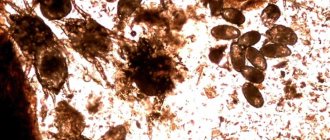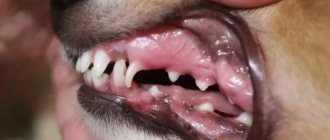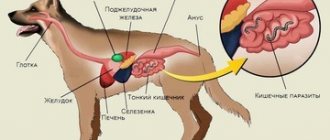Distemper in dogs is a dangerous disease that is accompanied by severe symptoms and long and expensive treatment.
The probability of death of an animal ranges from 50% to 90%, depending on how strong the immune system is and how quickly therapy was started.
The scientific name of the pathology is viral canine distemper (VCF) or Carré's disease. It is caused by a paramyxovirus. It is genetically similar to the causative agents of rinderpest, as well as measles in humans, but is not transmitted to humans.
Which dogs are at risk for the disease?
Puppies and young dogs are most prone to this disease; the most dangerous period is considered to be from three months to one year. During this period of life, the animal’s teeth are replaced, the immune system becomes weak, and the body is exposed to various kinds of diseases. If the puppy is still being fed by its mother, then it is in little danger of distemper, because antibodies against this terrible disease enter the body with milk, but there are exceptions.
Dog breed has nothing to do with predisposition. Both a mongrel and a pedigree dog can get distemper. The peak incidence is noted in spring and autumn, and it is during these times of the year that every owner should know how to treat distemper in a dog. Providing first aid on time will speed up the recovery process and minimize the possibility of death of the animal.
Consequences of distemper for dogs
If a dog does not die as a result of infection with plague, it develops lifelong immunity to this disease. However, such cases are quite rare, since most often the pathology leads to death.
In a dog that has suffered from distemper, traces of the destructive work of the virus in the body remain for a long time. They depend on the medical history and may manifest as:
- blindness;
- deafness;
- loss of smell;
- overgrowth of the pupil and scars on the cornea;
- yellowing of teeth.
Some individuals experience cuts, paralysis, and epileptic seizures.
Causes of infection
Distemper is caused by a virus that is most dangerous for animals. It penetrates through the respiratory tract or orally.
The main source of infection is interaction with a sick animal; in this case, the dog emits the virus through saliva, urine or feces. If a dog is sick with distemper, then the virus is on all objects that came into contact with it, and these things need to be eliminated; the best way is to burn them. Do not throw away these items; they may cause infection to another animal. Never accept used items from a deceased dog as a gift, as they may carry a dangerous virus. Common causes of animal infection are:
- feeders;
- toys;
- beds;
- carrier bags;
- enclosures that have ever contained infected individuals.
If the dog is a pet and does not interact with other animals, this does not mean that it is safe. The cause of infection can even be ordinary dirt on a person’s shoes, brought home, clothes, or the remains of dirt on a dog’s paws after a walk.
The danger of infection occurs in early spring and late autumn, when above-zero temperatures are not as high as in summer. It is at this time of year that you need to especially protect your pet. So, how to treat distemper in a dog?
General disease prevention
Timely vaccination of dogs against canine distemper will help protect your pet from infection with a dangerous virus. The first vaccination for puppies is given at one and a half months of age, and then annually. The appearance of immunity after vaccination does not occur immediately, but after a month (after revaccination).
To spot signs of a dangerous disease in time, animal owners must:
- treat your pets carefully;
- monitor their health;
- systematically carry out hygiene procedures;
- to keep clean;
- feed properly;
- include mineral and vitamin preparations in the diet;
- When walking, avoid contact with street dogs.
There are two vaccines against canine distemper:
- with a weakened virus – protects for a year, but gives complications in the form of fever and swelling;
- with a dead pathogen - the effect is less pronounced, but there are no complications, the vaccination is repeated three times a year.
Among domestic vaccines, Multikan-6.8 follows, and among foreign drugs, the effective use of Nobivak, Dipentovak, Pentodog, Kanvak, Hexodog and Vanguard.
It is advisable to carry out revaccination with the same drug as the first vaccination, in order to avoid conflict of strains in the composition of different medicines.
Most often, animals do not react to the vaccine, but mild swelling and pain at the injection site and a slight increase in temperature may occur.
Before vaccination, the dog must be examined, and after it, the pet must be monitored.
Infection period
From the moment the animal comes into contact with a sick individual or with an object carrying the virus, the dog is affected by the disease. But in the first 5-20 days, the dog is only a carrier and distributor, and it is almost impossible to find out that the pet is sick.
The incubation period makes it difficult to diagnose symptoms of distemper in dogs. How to treat your pet during this time? If you see that something is wrong with your dog, but are not sure that it is distemper, then be sure to contact a veterinarian; you cannot self-medicate. The only thing is that you need to provide first aid using folk remedies, which we will talk about later.
When signs of distemper appear in dogs, a veterinarian will tell every dog owner how to treat it. Urgent treatment should be started with the following symptoms:
- A short-term increase in body temperature up to 40 degrees. The fever subsides on its own, and therefore one can note strangeness in the animal’s behavior: the dog is either active or becomes lethargic.
- Appetite decreases, even if the pet loves to eat. The dog even refuses his favorite treats and becomes lethargic.
- The mucous membranes begin to turn red.
- Diarrhea, cough, vomiting always accompany plague.
- The dog begins to be afraid of the light, its eyes water, it hides in the dark corners of the house, and refuses to go for a walk.
- The most recent signs are the inability to get up. The dog becomes weakened, lies down, does not respond to the owner’s voice and does not respond to stimuli. Heavy breathing, protruding tongue and rapid or, on the contrary, weakened heartbeat.
The disease primarily affects the gastrointestinal tract and respiratory system. The virus affects the central nervous system, and the animal experiences convulsions, coordination of movements becomes confused, and paralysis occurs. All the latter symptoms are one hundred percent signs of nervous distemper in dogs. Everyone should know how to treat this disease at home, because the disease cannot be left without treatment; the fatal outcome with plague is 90%. The sooner you start treatment, the greater the chances of rescuing your pet from the other world. Is it possible to treat a dog with distemper with vodka? This question constantly appears on the Internet. Answer: you can, vodka will be an excellent first aid. We will write below how to do this.
How is it transmitted?
Distemper is not only a dog disease; many animals are susceptible to it. The main source of the virus is an infected animal. Experts answer in the affirmative to the question of whether a dog can become infected with distemper from a cat. Yes, it is passed from dog to dog, but other animals can also take part in the chain.
The virus, which is the causative agent, persists in the patient’s saliva, which remains on many objects. Therefore, the main sources of infection are:
- infected animals;
- bedding;
- feeders;
- enclosures, booths;
- human clothing, shoes (after staying in an infected place).
Many people are also interested in whether a person can become infected with distemper from a dog. The disease is not transmitted to humans, no matter in what form it occurs. Paramyxovirus, which provokes an inflammatory process, is absolutely safe for the human body. Therefore, distemper is not contagious to people; the main danger to humans is the risk that a sick dog will infect other pets.
Considering that distemper is transmitted even through human clothing and shoes, the owner himself can become a source of infection for domestic animals. A puppy can get sick because the owner is visiting, on the street, and pets a sick dog or cat.
Incubation period
The incubation period for an animal lasts from three days to three weeks. This is the time that elapses from the moment the virus is introduced into the animal’s body until the first symptoms of infection appear. In rare cases, when the animal belongs to hardy breeds characterized by excellent health, the incubation period lasts up to several months.
Breeders involved in breeding new breeds and propagating old ones pay special attention to strengthening the immune system. Due to this, most dogs today experience mild clinical manifestations of distemper. Because of this, the incubation period often proceeds in an apathetic form - there are no obvious signs of infection, such as an increase in body temperature, etc. The dog simply hides from people, sleeps a lot, refuses to eat.
How dangerous it is for humans
Canine distemper is dangerous to humans only on the aesthetic and moral side of the issue. Considering that the fatality rate of the disease makes up a significant part of all infections, a loving owner will worry about his pet. He has the power to minimize the likelihood of death, but not to prevent it.
Treatment at home requires special care for the animal, which requires additional time, effort, and money. You will have to approach the issue of feeding especially carefully. Therefore, it is important for people who have their own pets to take precautions so as not to become a source of infection themselves. If the dog gets sick through no fault of theirs, it is necessary to provide it with appropriate care.
Course and diagnosis
The intensity of the disease depends on the dog’s immunity. There are several forms of development of the disease:
- Lightning development - the dog has no symptoms, but dies within a day.
- Hyperacute course - the dog’s temperature rises sharply, it falls into a coma, and if treatment is not started, the animal will die within 2-3 days.
- Acute form of the disease - the dog exhibits the symptoms described above.
- Chronic distemper - symptoms appear and disappear, in this form the dog is a constant carrier of the virus.
Diagnosis of the disease must be made in a hospital. You will need to be tested to rule out other viral diseases whose symptoms are similar to plague.
Diagnosis and treatment
Timely diagnosis is an important and mandatory point before prescribing complex treatment. Clinical studies and laboratory tests are prescribed for the sick animal. Taking anamnesis is important.
A blood test in the early stages of a viral disease reveals leukopenia, damage to lymphoid tissue (depletion or destruction). It is important to carry out differential diagnosis. This allows us to exclude diseases similar in clinical signs to canine distemper - Aujeszky's disease (pseudorabies), leptospirosis, parvovirus and coronavirus infections, adenovirosis.
The prognosis depends on the severity of the disease. Thus, with a hyperacute form, the prognosis is lethal, while severe forms of distemper complicated by secondary microflora have an unfavorable prognosis. In the case of a mild course and timely treatment, the prognosis is cautious, closer to favorable.
Treatment is most effective at the very first stages of the pathology. Carnivore distemper, especially when it comes to puppies, affects several body systems, so therapy must be comprehensive, aimed at destroying the pathogen and maintaining homeostasis in the body.
The key areas of therapy for distemper in puppies are:
- Etiotropic. The main focus is to determine the cause of infection and the effect on the pathogen.
- Pathogenetic. It is necessary to distinguish the degree of pathogenetic changes and influence them, interrupting them (elimination of intoxication against the background of a viral infection).
- Symptomatic. The main direction is to eliminate certain symptoms associated with the disease (use of painkillers, cardiac glycosides, hepatoprotectors, antiemetic medications).
- Substitute. Allows you to replace the physiological functions of the body that are impaired during the development of the disease (necessary for normalizing metabolic processes and includes taking vitamin-mineral complexes, injections of physiological solutions).
Specific therapy includes the use of immune serums, special proteins (immunoglobulins), and antimicrobial drugs (in case of secondary pathogenic microflora). This type of treatment is necessary to suppress or completely destroy the pathogen in the dog’s body. Polyvalent serum against canine distemper, parvovirus enteritis and adenovirus infection has a good therapeutic effect.
Treatment tactics should be developed by a veterinarian based on the laboratory data obtained and the general condition of the animal. The dosage, duration of therapy and treatment regimen are prescribed by the doctor, taking into account individual characteristics.
The dog owner must strictly adhere to all regulations. In small puppies, all processes in the body proceed faster, so if characteristic signs of ill health are detected, it is important to provide him with timely qualified assistance.
How to treat distemper in a dog?
It is advisable to send your pet for treatment to a hospital, where professionals will take care of it. If this is not possible, then call a veterinarian at home so that he can make an accurate diagnosis and prescribe treatment.
Since there is no cure for distemper, the fight against the disease is by increasing the animal’s immunity, which will itself fight the virus. The owner requires attention, love, support. It is necessary to build a place for the dog in the dark where it will not be disturbed by light. You also need a special diet. We will tell you in the following content what to feed your pet during illness.
Can a vaccinated dog get distemper?
Unfortunately, even vaccinated animals are at risk of developing this virus. To date, doctors have still not been able to develop a drug that guarantees 100% protection against this pathology. The likelihood of infection especially increases if the owner did not follow the preparation recommendations before vaccination. The greatest risk of developing distemper is present in puppies, since their body and immune system have not yet become stronger.
Treatment by a veterinarian
Distemper poses a relatively low danger to adult dogs that have been vaccinated long ago. However, in any case, owners should not forget about disease prevention and the need for re-vaccination.
Specific treatment
Unfortunately, there are no magic injections for plague yet. Scientists are trying to develop them, but so far to no avail. But there are serums that will help minimize the possibility of death - these are liquids with antibodies obtained by processing the blood of animals with high immunity to the disease. The following serums are prescribed:
- "Vitafel";
- "Gixan";
- "Globcan";
- "Avirokan" and the like.
In rare cases, a blood transfusion from an immune dog is used.
The difficulty of such therapy is that the serum must be administered at the very beginning of the disease, and as we have already understood, symptoms can appear both on the first and on the twentieth day after infection. The sooner the serum is administered, the greater the chance of a successful outcome. If you use the serum too late or abandon it altogether, then in rare cases a miracle of healing can occur. When the disease is advanced, all that remains is to rely on the strength of the immune system and the pet’s zeal for life.
The serum should be administered to the animal 1-2 times a day. Since we are talking about the introduction of a foreign protein, you must first inject Diphenhydramine to eliminate allergies.
Why are vaccinations needed?
Man has changed the biology of dogs. Breeds with specified qualities have been created. The price for this was a weakened immune system. Outbred dogs are constantly faced with the attack of viruses, so they have inherited immunity to such dangerous diseases as canine distemper. If they become infected, the disease is mild, ending with a quick recovery. But purebred animals are defenseless against the virus and die without treatment. Puppies suffer the most.
Carnivore plague
Of course, there is a chance that animals that are not in contact with anyone will not get sick, but the virus can be brought in by the owner by interacting on the street with many people who have had contact with carnivorous animals.
If a dog handler intends to participate in expert exhibitions, breeding, and receive awards, he is obliged to vaccinate the dog. Vaccination is confirmed by a mark in the veterinary passport, which is certified by the seal of the clinic.
Veterinary passport
Vodka for plague
Treating distemper in a dog with vodka is a proven folk method that has helped save the lives of many four-legged animals. You can give your dog a forty-degree “medicine” in two ways:
- Take a large syringe and remove the needle. Fill it with vodka in the amount of 30-50 grams (depending on the size of the animal), pour it into the mouth, hold the head until the dog completely swallows the drink. Give water to avoid burns to the mucous membranes. This procedure is carried out twice a day. Usually on the second day the dog becomes more active, he develops an appetite, which means that he is on the mend.
- Second method: dilute one raw egg in half a glass of vodka, stir well. Divide the product into two halves, pour one portion into the animal’s mouth, and the second after 12 hours.
Now you know how to treat your dog for distemper at home while you wait for the vet to arrive. Of course, it will not be possible to cure an animal with vodka alone; other therapy must also be used, but this drink will minimize the likelihood of death and help the pet recover faster.
Disease prevention
Since there is no vaccine for distemper, and the outcome of the disease is often unfavorable, it is incredibly important to prevent the disease and vaccinate your pet on time.
When should a dog be vaccinated against distemper? The vaccination procedure is simple. The first vaccination is carried out at 2-3 months of age. It is very important to worm the puppy first. Repeated vaccination must take place 2 weeks after the first. This is important so that the animal develops a strong immunity against the disease. To maintain immunity, revaccination is necessary annually.
As you can see, it is much easier to prevent a disease than to treat it later. Therefore, do not neglect timely prevention and observation by a doctor if you wish health and a long happy life for your pet.
Respiratory manifestations
Can distemper in dogs be treated with antibiotics? Serum and vodka alone will not save the animal. How to treat distemper in a dog at home? The veterinarian will prescribe complex therapy, the regimen of which must be strictly adhered to. In case of respiratory manifestations of the disease (sneezing, coughing, dry nose and cracked earlobes, inflammation of the eyes), it is necessary to contain the reproduction and spread of harmful bacteria. Therefore, it is also necessary to treat distemper in dogs with antibiotics. These medications will only help to cope with the proliferation of bacteria when respiratory symptoms appear, but antibiotics do not treat the plague itself. The doctor will prescribe Ampicillin, Levomycetin, Sulfalen, Sumetrolim, Streptomecin or another antibiotic.
If you do not use it, it will worsen - blindness, loss of smell, pneumonia, bronchitis or pulmonary edema.
Antibacterial drops should be used to clean the eyes and nose. Avoid crusting.
Diagnosis of the disease
If a differential diagnosis method is used, the veterinarian must exclude diseases similar in clinical manifestations to distemper:
- adenoviral pathologies;
- leptospirosis;
- enteritis;
- Aujeszky's disease;
- food poisoning.
The pet's blood and feces are analyzed to detect the virus.
In addition, much attention is paid to collecting anamnesis. During the examination, the veterinarian must ask the animal owner the following points:
- vaccinations performed - serum composition and timing;
- possible sources of infection;
- nuances of maintenance, feeding and care.
Due to the fact that the virus manifests itself in many forms, making a diagnosis without laboratory tests is difficult.
The weak immunity of puppies cannot cope with distemper
How to treat intestinal distemper in dogs
With this type of distemper, dogs will vomit profusely and have foul, loose, yellow stools. There is often mucus and even blood in the stool. You cannot do without qualified help; you need to urgently call a doctor. The veterinarian will prescribe droppers of plasma-substituting solutions and salts: lactosol, disol, sodium chloride plus 0.5 glucose.
To stop diarrhea and vomiting, so that dehydration does not occur, the following medications are prescribed:
- "Bifikol";
- "Cerucal";
- "Intestopan";
- "Abomin";
- “Smecta” and others that help eliminate toxins and stop diarrhea and vomiting.
There are also folk remedies for normalizing the gastrointestinal tract and removing toxins. Give your dog carrot juice, linden and chamomile decoction. If the dog refuses to drink it voluntarily, then force it in.
With this form of plague, treatment with vodka is unacceptable. The drink will harm already irritated mucous membranes and cause severe dehydration.
Forms of plague
There are several forms of plague.
Nervous
If the dog is not treated, it will reach this stage at the end of any other type of distemper. This type of disease is accompanied by nervous tics and twitching.
Reference. Aggression and irritability are clearly manifested. In the end, epileptic seizures are possible. Death is caused by paralysis of breathing and cardiac muscle.
Pulmonary
This form develops when the virus accumulates and develops in the respiratory tract. The main symptom is high fever and cough. The dog does not eat, but thirsts for plenty of water. Further, diarrhea and vomiting are probably added, and purulent discharge from the eyes and nose.
Intestinal
A characteristic feature in this case can be considered vomiting and yellow diarrhea with an extremely unpleasant odor. A white coating forms on the tongue, and the tooth enamel darkens. There is also general weakness of the body and lack of appetite, loss of consciousness is possible.
Other types of illness
If plague affects the nervous system, the doctor should prescribe the following medications: Mydocalm or analogues - to reduce muscle tone, Pagluferal 2 for epilepsy, for weakness and partial paralysis - one percent Strychnine, in case of severe excitability - diphenhydramine with Aminazine ", benzonal, folic acid, sodium barbital. Intracranial pressure will help reduce 25% magnesium sulfate.
When skin lesions are caused by plague, blisters and crusts appear on the skin, which must be treated with an antiseptic ointment. To prevent your pet from scratching the sores and not licking the ointment, you will need to wear a protective collar. In severe cases, immunostimulants, antibiotics and vitamins are prescribed.
The dog fell ill with distemper. How to treat? Do not give your animal medicine from your first aid kit just in case it helps. All recommendations should only be given by a veterinarian. The article describes the remedies for informational purposes only; the doctor will prescribe the correct dosage and, possibly, other medications.
Treatment of canine distemper
Since the pathology affects all vital organs, it refers to multisystem diseases. Complex therapy is used using a large number of medications and immunological serum.
Basic principles of treatment:
- maintaining general tone;
- relief of symptoms;
- combating dehydration;
- prevention of bacterial activity.
"Giskan-5" - an effective serum against canine distemper
Treatment is most effective in the early stages of the disease.
Table 5. Treatment of distemper in dogs
| Direction of drug treatment | Prescribed drugs |
| General therapy | Administration of the following drugs intravenously:
|
| Maintenance therapy | Subcutaneous injections of vitamin B complex. |
| Destruction of the pathogen |
|
| For paresis | Subcutaneous injections "Prozerin". Duration - 10 days. |
| To reduce muscle tone | Dragee "Mydocalm" 3 times a day until symptoms disappear. |
| To normalize the emotional state |
|
| For epilepsy |
|
| Against bacterial infections |
|
| To support immunity |
|
When treating pathology, you need to regularly clean your pet’s mucous membranes.
Crusts should not be allowed to form on the mucous membranes. In order to prevent the development of inflammatory processes, the following drugs are suitable:
- "Tsiprovet";
- "Lacrican";
- "Tetracycline ointment."
Eyes and nostrils are treated 2 times a day. If the oral mucosa is damaged, use the Furacilin solution.
The oral cavity must be treated with Furacilin
Home therapy
Completing a therapeutic course at home is possible only if you have a treatment regimen approved by a veterinarian and skills in administering IVs and injections.
Basic rules of care:
- The pet is placed in a separate darkened room, without drafts, with moderate humidity.
- Walking is prohibited.
- The chest is wrapped in woolen cloth.
- Representatives of smooth-haired breeds are given mustard plasters for 5 days.
- For dogs with a lot of hair, bandages based on hot sand or salt are suitable.
- 2 times a day it is necessary to warm up the limbs in water at a temperature of about 60°C. You can add a small amount of mustard to the bowl of liquid. This will enhance the thermal effect.
Infrared lamps are effective for deep heating.
Infrared radiation is useful in warming extremities
Traditional methods
Since distemper is a highly contagious disease, using remedies from a home medicine cabinet is not effective. Folk remedies will only help as maintenance therapy.
Popular recipes:
1. Herbal decoctions. The following plants are used:
- motherwort;
- flax seed;
- St. John's wort;
- horse sorrel;
- serpentine rhizome;
- bird cherry;
- marshmallow root;
- swamp grass;
- blueberries;
- series;
- St. John's wort;
- sage leaves;
- chaga rhizomes;
- Oak bark;
- calamus;
- oregano;
- chamomile;
- cinquefoil erect.
These plants have various therapeutic effects, from astringents to anti-inflammatory. Depending on the symptoms present, a remedy is selected from the list and the dog is given 200 ml per day until complete recovery.
Herbal infusions are used as therapy
2. A mixture of eggs and honey. Soften 1 raw chicken egg and combine with 20 g of honey. Give to the animal several times a day for 3 days.
3. A mixture of vodka, eggs and honey. 1 tbsp. alcoholic beverage mixed with 1 tbsp. honey and 1 yolk. Pour several grams into the animal's mouth 3 times a day for 4 days.
Drinking vodka can negatively affect your pet's health
Most experts agree that distemper should not be treated with alcohol-containing liquids. Alcohol destroys mucous membranes, reduces the body's protective functions and leads to disruption of cellular metabolism and dehydration.
Diet
We must not forget about special feeding during plague. Food should help boost immunity so that the body can fight harder:
- give more minced meat or finely chopped meat;
- raw egg - twice a week (during illness and during recovery);
- low-fat cottage cheese and kefir;
- broths from meat and vegetables are required; if you cook porridge, then make it liquid, like soup;
- A decoction of motherwort must be poured into drinking water during damage to the nervous system.
Incubation period and forms
The incubation period, when the disease manifests itself only in weakness and loss of appetite, lasts 2-24 days. In rare cases, the secretive stage lasts up to 1 month. But already at this time the pet is contagious and poses a potential threat.
The course of the disease is divided into 4 forms:
- Fulminant (often found in unvaccinated puppies 1-2 months old, passes without symptoms; kills the dog in 2-24 hours; the form is incurable);
- Acute (similar to the fulminant form, it occurs in small puppies, the course drags on for up to 2-3 days, while appetite decreases and the temperature rises to 41°C, after which coma and death occur);
- Subacute (manifested by fever from 2-3 days to 2 weeks, accompanied by fearfulness, apathy, lack of appetite, after which typical signs of a viral disease develop);
- Chronic (characterized by all of the above symptoms, the course of the disease can last from 2 months to several years, sometimes fading, sometimes appearing).
The plague is also divided into subtypes, depending on the clinical symptoms and the severity of their manifestation. The variability depends on the strength of the virus and the body’s resistance. In addition, the shapes can be mixed or flowing.
Pulmonary form
From the name it is clear that the main affected area is the dog’s lungs. This causes pneumonia and severe swelling. The pet is breathing heavily, coughing, wheezing, and sneezing. Mechanical creaks are heard inside the chest during medical listening. The temperature rises and does not fall for about 2 weeks.
The most striking symptom of the form is rotting of the nasal passages, causing fluid to flow and plugs that make breathing difficult. The nasolabial mirror becomes covered with crusts and cracks.
Due to sudden increases in body temperature, conjunctivitis with purulent discharge appears, the iris becomes inflamed, and ulcers are visible on the cornea of the eye. After 3 weeks, in addition to the typical manifestations of the form, damage to the nervous system and catarrhal disorders occur.
Intestinal form
The symptoms of this form are directly related to the typical acute courses of gastroenterological diseases. First of all, the pet loses its appetite, is picky in choosing food, and loses weight. Then diarrhea appears, bloody diarrhea with yellowish or gray mucous discharge. If the rectum is affected, the color of the feces will be black due to internal hemorrhage.
Also a characteristic symptom is severe periodic vomiting with bile or blood. The eruptions, like the pet itself, emits a rotten, corpse-like odor.
Cutaneous form
The form manifests itself as a reddish rash in the ears, on the nose, around the eyes, and on the thighs. The pimples that appear become inflated and filled with purulent fluid. After the bubble bursts, a brown crust forms in its place. The sizes vary from a grain of rice to a coin.
In some cases, the skin on the joints and folds becomes hard. There is a well-known symptom called “stiffness”, when the pads of the limbs become denser, the skin cracks, which causes pain.
Nervous form
Sooner or later, this form replaces all previous ones, because the virus actively affects the nervous system. May manifest as aggressiveness or overexcitement of the pet. This stage is wave-like in the severity of symptoms. It may seem that the dog is getting better, but a relapse is inevitable in a week or a week and a half.
Characteristic symptoms: cramps of individual muscles or the whole body, loss of coordination, the animal staggers when walking, may fall; facial spasms; epilepsy leading to paralysis of the entire body or internal organs (rectum, bladder, etc.).
Mixed form
At the same time, symptoms of all forms appear; the virus affects and causes spasms of the listed organs and systems. It brings the greatest suffering to the pet; as a rule, this form is either lightning fast or acute.
Immunization rules
There are passive or active methods of immunizing animals. If for some reason vaccination is dangerous, for example, if there is a threat of infection, hyperimmune serum or globulin containing antibodies against plague and other diseases is used. The protection lasts for two weeks, after which you can get vaccinated. It is impossible to vaccinate before - serum antibodies will destroy the weakened pathogen, and the production of immune globulins will not occur.
It is necessary to carry out preparatory measures. Whether the puppy has worms or not, it doesn’t matter. Preventive deworming is carried out 10–14 days before vaccination. You cannot immunize before because the body is weakened by taking a potentially toxic drug. In addition, you need to get rid of fleas.
If the bitch was vaccinated before breeding, her colostrum will provide the puppy with antibodies that provide passive immunity until the age of eight weeks. After this, the supply of protective globulins runs out. At this age, the puppy must be vaccinated. This immunization is called active. The dog is injected with a weakened or killed microbial culture. For injections, disposable syringes are used, individual for each puppy.
It takes about two weeks for antibodies to form in a concentration that can reliably repel a contagion attack. At this time, the animal must be isolated from its relatives and not walked on the street, so as not to become infected. If the bitch was not vaccinated before mating, one and a half month old cubs have to be immunized.
The puppy's defense system is imperfect. Therefore, after 3-4 weeks the puppy is revaccinated. Most manufacturers recommend immunizing dogs at 6, 12 months and annually.
Hexakanivac











